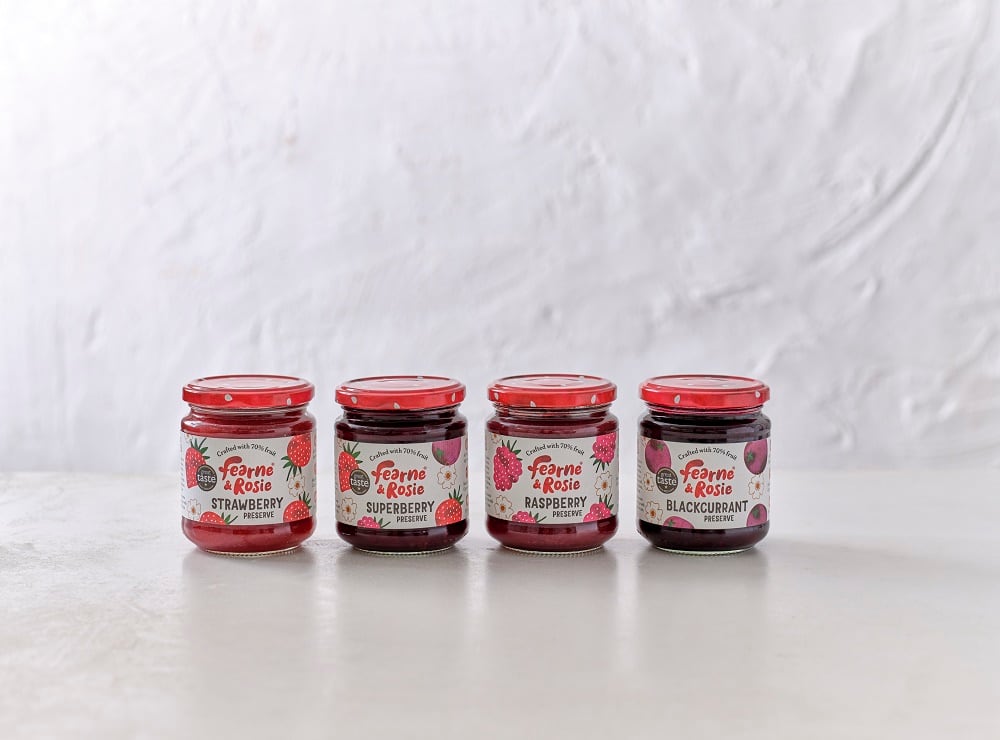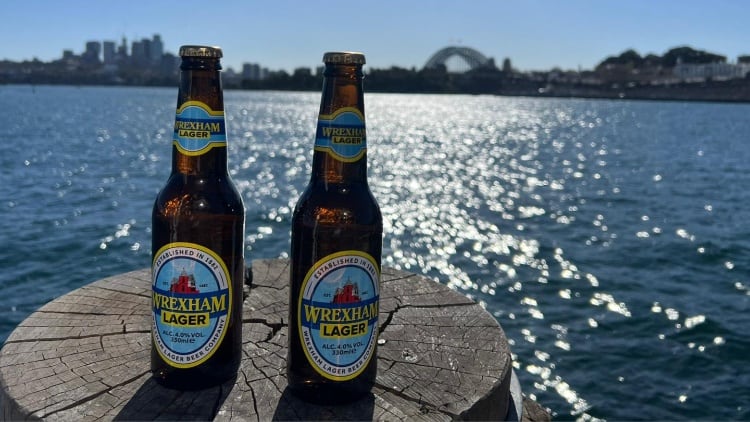Fresh new look for Fearne & Rosie jam

British Jam brand Fearne & Rosie has a revealed a fresh new look for its range of reduced sugar spreads to coincide with their nationwide rollout this month.
Now available in Tesco stores across the country, the new design – created in partnership with Bun Studio – emphasises the brand’s more mature, premium look while maintaining its ‘original essence of playfulness’.
As Victoria Hemphill at Bun Studio explained: “Logo refinement, soft textures, hand-drawn illustrations and a simplistic colour palette helped us achieve this.
“The packaging looks clean and striking on shelf with the red berry lids aiming to give consumers a sense of home and comfort. Working with Rachel was brilliant and I feel we managed to capture everything she had hoped for.”
The new look coincided with a brand-new national listing with Tesco as part of the retailer’s 2024 Accelerator Programme. It joined 15 others as part of the initiative, which aimed to introduce small and ‘trend-led’ brands into the supermarket.
“In order to become the market leader in jams, we need to broaden our appeal and become more mainstream, offering an accessible, premium alternative,” explained founder Rachel Kettlewell.
“We want to be both accessible, and indulgent, sitting beautifully in customers' kitchens and making them smile. We’re so excited to hear what our customers think, and hope they will be encouraged to keep and reuse the jars too.”
‘Comprehensive’ redesign for Purely Organic
Purely Organic – Noble Foods’ organic egg brand – has revealed a ‘comprehensive’ redesign across packaging and online.

The first major update for the brand since its launch, the new look aimed to reinforce Purely’s commitment to nature and sustainability, showcasing the benefits of organic farming and appealing to a growing audience of eco-conscious consumers.
New packaging has been designed for both six and 10 packs of eggs, as well as new POS materials and a redesigned website featuring ‘wholesome’ recipe content.
"Our goal with this refresh for Purely Organic is to bring nature back to the heart of the brand,” said Anita Nutchey, marketing manager at Noble Foods.
“While the new design and colourful packaging convey a better sense of the brand itself, we want to emphasise our commitment to organic farming practices and nature, through the quality of our eggs, which come from hens raised under the highest welfare standards.”
Purely Organic is the latest brand in the Noble Foods portfolio to receive a design overhaul, with flagship free-range brand The Happy Egg Co. and Freshlay Farms Golden Yolkers receiving significant design investment within the past year.
“We're not just investing in a new look; we're also investing in the future of the organic egg category,” Nutchey continued. “We aim to engage more consumers with the benefits of choosing organic eggs, promoting a better understanding of why Purely Organic stands out in the market.”
Targeting the eco-savvy at Wenlock Spring

Water brand Wenlock Spring is hoping to draw in the eco-savvy GenZ crowd with a revamp of its popular cans.
The move away from the firm’s existing branding with a new bold typography-led aesthetic in a bid to boost chiller presence alongside a growing number of popular canned beverages now on offer in foodservice sectors.
By packaging the product in cans, not only does Wenlock tap into the growing trend of canned beverages in the RTD market, but the brand also appeals to younger consumer on the lookout for eco-conscious producers.
Using manufacturing methods designed to protect the environment while reducing the company’s carbon footprint, each new can takes just 60 days to be recycled and remade into a new one using 95% less energy than using raw materials.
Matthew Orme, director at Wenlock Spring, said: “Aluminium cans are having a moment in the water category, as consumers and businesses reach for convenient, recyclable packages.
“Making aluminium cans from recycled metal is 20 times more energy efficient than using raw materials and a process that can be repeated over and over again, making them a great choice. They can be recycled and remade into new cans in just 60 days – it’s a true closed loop.
The move to aluminium cans also presents greater opportunities for growth at outdoor events and festivals, a prime market for RTD drink products.
“With a focus on bolder aesthetics, increased brand cohesion, and enhanced shelf presence, we wanted to redesign our cans to create a stronger and more distinctive visual identity that strengthens our position in the market and ensures we remain at the forefront of the industry,” Orme added.
“The younger generation is also bringing unique, often online influenced habits to beverage consumption which our industry needs to be aware of, with many seeking eco-friendly products and low and non-alcoholic drinks as they turn to healthier lifestyles.”
Young’s switches up Chip Shop’s visual identity
Young’s has relaunched its Chip Shop brand with a new visual identity that draws heavily on a traditional British takeaway staple.

Rolling out from the end of September, Young’s hoped the redesign would reinforce the brand’s ‘distinct Chip Shop proposition’ – an affordable alternative to the classic fish and chip takeaway.
The new design makes the brand’s taste promise to deliver ‘A Proper Taste of the Chippy’ much more prominent on pack, alongside a new logo and modernised illustrations. It also communicates that the products are ‘perfect for airfrying’ on pack for the first time, tapping into the growing use of airfryers within the home.
Matthew Wilson, marketing controller at Young’s Chip Shop, said: “Young’s Chip Shop has been Britain’s favourite battered fish brand for over 40 years, and we are seeing tremendous growth with more shoppers buying more packs, more frequently.
“With a record year of growth behind us, we felt it was time to evolve the Chip Shop brand to communicate our distinct chip shop taste credentials in a more modern way that could appeal to our existing target consumers and a new, younger generation of shoppers as well.”





